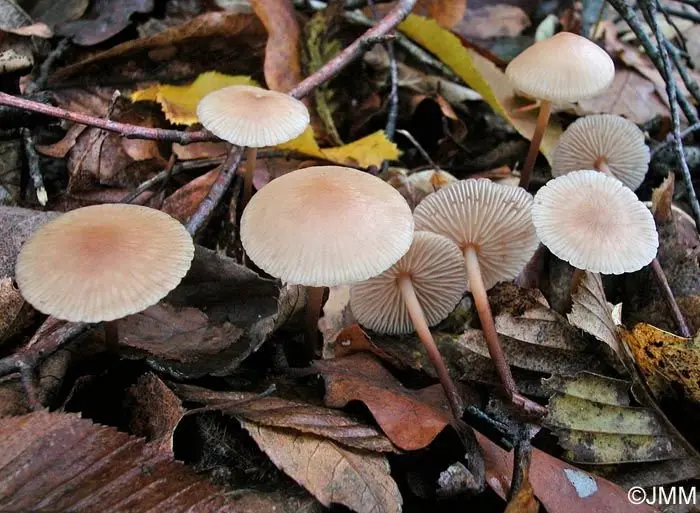Oak garlic (Marasmius prasiosmus)
- Division: Basidiomycota (Basidiomycetes)
- Subdivision: Agaricomycotina (Agaricomycetes)
- Class: Agaricomycetes (Agaricomycetes)
- Subclass: Agaricomycetidae (Agaricomycetes)
- Order: Agaricales (Agaric or Lamellar)
- Family: Marasmiaceae (Negniuchnikovye)
- Genus: Marasmius (Negnyuchnik)
- Type: Marasmius prasiosmus (Oak garlic plant)
- Oak fire pit

Hat:
in a young mushroom, the cap has a bell-shaped shape, then the cap acquires a rounded-convex or prostrate shape. Slightly blunt, wrinkled, semi-membranous in central part. The cap is XNUMX to XNUMX inches in diameter. In wet weather, the edges of the cap become striped, the cap itself is dirty-yellow or whitish. In the middle it is darker, brownish. As it matures, the cap fades to almost white, while the central part of it remains dark.
Records:
slightly adherent, sparse, whitish, yellowish or cream. Spore powder: white. Spores: unequal, ovoid.
Leg:
a long thin leg, five to eight centimeters long and no more than 0,3 centimeters in diameter. Firm, creamy, brownish-creamy or pinkish-creamy in the upper part. The lower part is brown, with a white pubescent base. Curved leg, slightly thickened towards the base. Usually the stem merges with the substrate.
Pulp:
in the cap the flesh is thin, light. It has a strong garlic odor.
Oak garlic is found in mixed and oak forests. It grows infrequently, on leaf litter, usually under oak. It bears fruit annually from early September to mid-November. Especially mass growth is noted in October.
Oak garlic is eaten fresh and pickled. After boiling, the garlic smell of the mushroom disappears. It is recommended to collect only mushroom caps. When dried, the mushroom smell does not disappear, so garlic powder can be used as a seasoning throughout the year. In Western European cooking, this mushroom is highly valued as a spice.
The Oak Garlic has similarities with the Ordinary Garlic, from which it differs in growing conditions, large size and cream-colored legs.
Video about mushroom Garlic oak:









